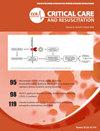icu获得性高钠血症:患病率、患者特征、发展轨迹、危险因素和结局。
IF 1.4
4区 医学
Q3 CRITICAL CARE MEDICINE
引用次数: 0
摘要
目的:对重症监护室(ICU)获得性高钠血症(ICU- ah)的认识一直受到缺乏颗粒数据的阻碍,并受到变量定义和纳入标准的混淆。设计:多中心回顾性队列研究。环境:澳大利亚昆士兰州(QLD)的12个icu。研究对象:2015 - 2021年ICU收治的成年患者。仅考虑首次入住ICU的患者,我们将患者分为轻度(146-150 mmol·L-1)、中度(151-155 mmol·L-1)和重度(bb0 155 mmol·L-1) ICU获得性高钠血症。主要结局指标:我们旨在研究ICU-AH的患病率、患者特征、发展轨迹、危险因素和结局。结果:来自55,255例ICU入院患者的数据被纳入分析,其中4146例(7.5%)患者患有ICU- ah。这些患者被细分为轻度(n = 2670, 4.8%)、中度(n = 1073, 1.9%)和重度(n = 403, 0.73%)。入院后至诊断的中位时间为4 (2-6)d,至血清钠水平峰值的中位时间为5 (3-8)d。整个队列的中位最高钠水平为149 (147-152)mmol·L-1。钠校正率为每天1 mmol·L-1,钠水平恢复到145 mmol·L-1以下平均需要3 d(1-5)。APACHE III评分、有创通气、发热、高钠血症前一天使用利尿剂是中重度ICU-AH的独立危险因素。在调整混杂因素后,所有水平的高钠血症与院内30天死亡率风险增加独立相关。结论:在一项针对危重患者的大型多中心研究中,ICU获得性高钠血症发生率为八分之一,住院时间中位数为4天,且在此之前存在可识别且可改变的危险因素。如果情况严重,那么它的修正是缓慢的,正常化也被推迟了。在校正其他因素后,所有水平的高钠血症都是30天住院死亡率的独立危险因素。本文章由计算机程序翻译,如有差异,请以英文原文为准。
ICU-acquired hypernatremia: Prevalence, patient characteristics, trajectory, risk factors, and outcomes
Objective
Knowledge of intensive care unit (ICU) acquired hypernatremia (ICU-AH) has been hampered by the absence of granular data and confounded by variable definitions and inclusion criteria.
Design
Multicentre retrospective cohort study.
Setting
Twelve ICUs in Queensland (QLD), Australia.
Participants
Adult patients admitted to ICU from 2015 to 2021. Only the first ICU admission was considered, and we categorised patients into mild (146–150 mmol·L−1), moderate (151–155 mmol·L−1) and severe (>155 mmol·L−1) ICU-acquired hypernatremia.
Main outcome measure
We aimed to study the prevalence of ICU-AH, patient characteristics, trajectory, risk factors, and outcomes.
Results
Data from 55,255 ICU admissions were included in the analysis, of which 4146 (7.5 %) patients had ICU-AH. These were subcategorised into mild (n = 2,670, 4.8 %), moderate (n = 1,073, 1.9 %) and severe (n = 403, 0.73 %) forms. Median time to diagnosis was 4 (2–6) d after ICU admission, while median time to peak serum sodium level was 5 (3–8) d. The median maximum sodium level across the cohort was 149 (147–152) mmol·L−1. The sodium correction rate was 1 mmol·L−1 per day, taking a median of 3 d (1–5) for sodium levels to return below 145 mmol·L−1. APACHE III score, invasive ventilation, fever, and diuretic use on the day before hypernatremia were independent risk factors for moderate or severe ICU-AH. After adjusting for confounders, all levels of hypernatremia were independently associated with an increased risk of 30-d in-hospital mortality.
Conclusions
In a large multicentric study of critically ill patients, ICU-acquired hypernatremia occurred in one in eight admissions after a median of four days in the ICU and was preceded by identifiable and modifiable risk factors. If severe, its correction was slow, and normalisation was delayed. After adjusting for other factors, all levels of hypernatremia were an independent risk factor for 30-d in-hospital mortality.
求助全文
通过发布文献求助,成功后即可免费获取论文全文。
去求助
来源期刊

Critical Care and Resuscitation
CRITICAL CARE MEDICINE-
CiteScore
7.70
自引率
3.40%
发文量
44
审稿时长
>12 weeks
期刊介绍:
ritical Care and Resuscitation (CC&R) is the official scientific journal of the College of Intensive Care Medicine (CICM). The Journal is a quarterly publication (ISSN 1441-2772) with original articles of scientific and clinical interest in the specialities of Critical Care, Intensive Care, Anaesthesia, Emergency Medicine and related disciplines.
The Journal is received by all Fellows and trainees, along with an increasing number of subscribers from around the world.
The CC&R Journal currently has an impact factor of 3.3, placing it in 8th position in world critical care journals and in first position in the world outside the USA and Europe.
 求助内容:
求助内容: 应助结果提醒方式:
应助结果提醒方式:


